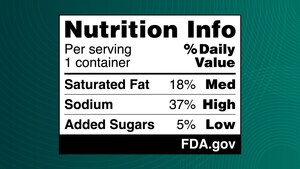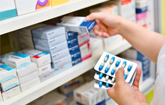National Diabetes Month: Keeping Nutrition and Food Safety in Mind
SILVER SPRING, Md., Nov. 7, 2023 /PRNewswire/ -- Did you know November is National Diabetes Month? Diabetes is a disease that happens when the level of glucose in your blood (blood sugar) is too high. It is important that people with diabetes keep nutrition and safe food handling in mind to help with their health and wellness.
Make Wise Food Choices
Healthy eating is one way to lower your risk of developing chronic diseases such as diabetes and can help people with diabetes manage their blood sugar. The Nutrition Facts label found on packaged foods and beverages is a tool you can use to make healthy food choices.
- Check the serving size and the number of servings you eat or drink to determine how many calories and how much of a nutrient you are consuming.
- Know your calorie needs. 2,000 calories a day is used as a general guide for nutrition advice, but calorie needs vary. Learn your number using the Estimated Daily Calorie Needs table.
- Use % Daily Value (%DV) to determine if a serving of the food is high or low in an individual nutrient and to compare food products (remember to make sure the serving size is the same). As a general guide:
- 5% DV or less of a nutrient per serving is considered low.
- 20% DV or more of a nutrient per serving is considered high.
- Consume a diet rich in dietary fiber, vitamins, and minerals. Choose foods that contain more of the nutrients you want to get more of and less of the nutrients you may want to limit. More often, choose foods that are:
- Higher in dietary fiber, vitamin D, calcium, iron, and potassium.
- Lower in saturated fat, sodium, and added sugars.
When eating out, use calorie information on menus and menu boards to make the best choice for you. Establishments covered by FDA's menu labeling requirements also have additional nutrition information available upon request. This information can help you make informed and healthful meal and snack choices.
Handle Foods Safely
People with diabetes are more likely to get sick from bacteria that cause foodborne illness, also called "food poisoning," and are more likely to be sicker for longer, be hospitalized, or even die. Some foods that are riskier generally fall into two categories:
- Uncooked fresh fruits and vegetables.
- Some animal products, such as unpasteurized (raw) milk; raw or undercooked eggs, meat, poultry, fish, and shellfish; luncheon meats; improperly reheated hot dogs; and salads containing animal products such as seafood, ham, or chicken that are prepared outside the home.
Anyone who is diabetic or who prepares food for people with diabetes should also carefully follow the four steps to food safety:
- CLEAN: wash hands and surfaces often
- SEPARATE: keep raw meats from other foods
- COOK: cook to the right temperature
- CHILL: refrigerate foods promptly
For more information:
- www.fda.gov/nutritioneducation
- www.fda.gov/food/people-risk-foodborne-illness/food-safety-older-adults-and-people-cancer-diabetes-hivaids-organ-transplants-and-autoimmune
Contact: Media: 1-301-796-4540 Consumers: 1-888-SAFEFOOD (toll free)
SOURCE U.S. Food and Drug Administration

WANT YOUR COMPANY'S NEWS FEATURED ON PRNEWSWIRE.COM?
Newsrooms &
Influencers
Digital Media
Outlets
Journalists
Opted In






Share this article